The official currency of Qatar is the Qatari riyal (QAR), which is divided into 100 dirhams. The Qatari riyal has been the country’s currency since 1973 when it replaced the Gulf rupee.
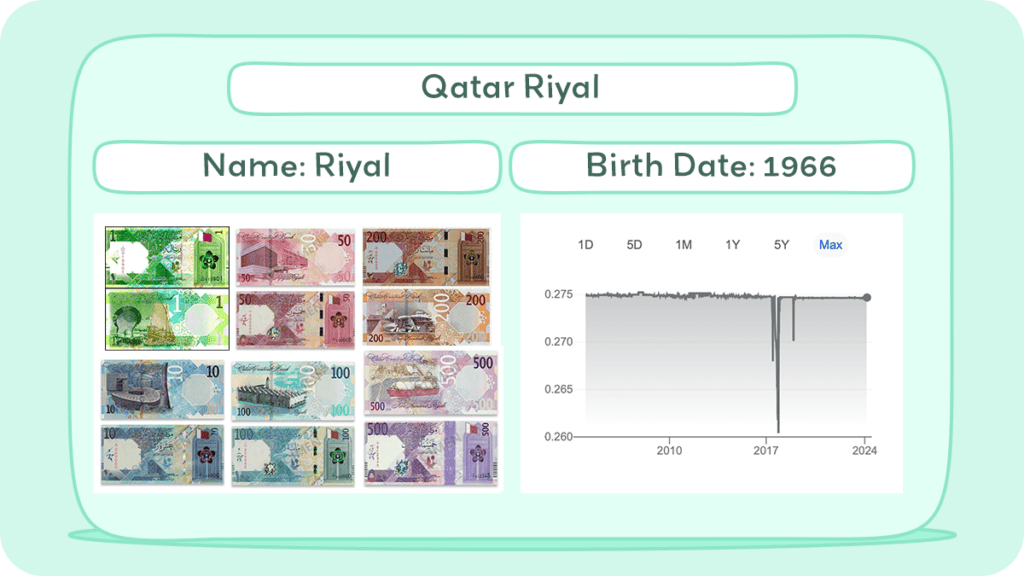
The banknotes come in denominations of 1, 5, 10, 50, 100, and 500 riyals, while the coins come in denominations of 1, 5, 10, 25, and 50 dirhams.
This article explores the history of the Qatari riyal (QAR), Qatar’s official currency. It covers the currency’s history, such as its origins before Qatar’s independence, the crucial adoption of the QAR, its integration into the Gulf Cooperation Council, and the ongoing impact of its peg to the US dollar.
Historical Journey of Qatar Currency
Qatar’s currency journey has been an interesting one, starting with the Indian rupee as its currency until 1966, in the form of Gulf rupees. When India devalued the rupee in 1966, Qatar, along with the other states using the Gulf rupee, decided to introduce its currency, the Qatar-Dubai riyal (QDR).
The Pound Sterling continued to provide cover for the new currency. On December 2nd, 1971, Dubai became a part of the UAE.
In 1995, the Qatar Central Bank was established to regulate and oversee the country’s financial system. The bank issued a new series of banknotes in 2003 with improved security features, including a hologram strip.
In 2017, Qatar faced a diplomatic crisis with several Arab countries. Saudi Arabia, Bahrain, and the UAE imposed a blockade on the country.
This led to a shortage of physical cash in the country, as many banks in the blockading countries refused to exchange Qatari riyals. To address this, Qatar’s central bank introduced new 500 riyal banknotes with enhanced security features and a new design, to encourage the use of electronic payments.
Today, the Qatari riyal remains a stable and widely accepted currency in the region, with a strong peg to the US dollar and a well-regulated financial system overseen by the Qatar Central Bank.
History of Coins
Until 1966, Qatar used the Indian rupee, specifically the Gulf rupee, as its currency. However, when India devalued the rupee that year, Qatar, like other states using the Gulf rupee, decided to introduce its currency.
Before this transition, Qatar temporarily used the Saudi riyal and then, in 1966, introduced the Qatar and Dubai riyal under the Qatar-Dubai Currency Agreement.
This new currency was initially equivalent to the Gulf rupee before its devaluation and was pegged to the British sterling.
However, following Dubai’s incorporation into the United Arab Emirates in 1973, Qatar started issuing the Qatari riyal independently. The old notes coexisted with the new ones for 90 days before being withdrawn from circulation.
In 1966, Qatar and Dubai introduced coins in denominations of 1, 5, 10, 25, and 50 dirhams. However, in 1973, following Qatar’s issuance of its currency, a new series of coins was released exclusively in Qatar’s name.
These coins maintained the same sizes and compositions as the earlier series. Currently, only the 25 and 50 dirham coins are commonly in circulation, although the smaller denominations remain legal tender.
The coins feature Qatar’s emblem, depicting two crossed swords and a sailing ship (dhow) on waves near an island with palm trees.
The 25 dirham coin has a diameter of 20 mm, a mass of 3.2 g, and is made of nickel-clad steel with a reeded edge.
The 50 dirham coin is slightly larger, with a diameter of 25 mm, a mass of 5.8 g, and a similar composition and edge. Both these coins were first minted in the year 2000.
History of Bills
The Qatari currency has undergone several changes since 1966, reflecting the nation’s development. Initially, the Qatar & Dubai Currency Board introduced banknotes in denominations of 1, 5, 10, 25, 50, and 100 riyals.
After Qatar’s independence in 1971, the Qatar Monetary Agency issued new notes in 1973 in denominations of 1, 5, 10, 100, and 500 riyals, adding a 50-riyal note in 1976. Following the establishment of the Qatar Central Bank in 1973, these notes continued to circulate for some time.
Over the years, Qatar has released multiple series of banknotes. The fourth series was introduced in 2003, followed by a revised version in 2007-2008, which included updates to the 100 and 500 riyal notes.
In 2020, the Qatar Central Bank issued the fifth series of banknotes, which introduced the 200 riyal banknote. The design of these notes features traditional geometric patterns, the Flag of Qatar, Qatari flora, and elements representing historic Qatari architecture.
Additionally, Qatar issued a commemorative 22-riyal note for the 2022 FIFA World Cup. This note displays various symbolic elements, including Doha, Lusail Stadium, a tower, a dhow, Al Bayt Stadium, and a globe, showcasing Qatar’s rich culture and modern achievements.
The evolving design and denominations of Qatari banknotes mirror the country’s economic growth and its increasing prominence on the global stage.
Inflation and Buying Power of Qatari Riyal
The inflation rate in Qatar has been relatively stable in recent years, with an average rate of 1.5% between 2015 and 2020, according to Trading Economics. This has helped maintain the buying power of the Qatari riyal, which has remained strong against other major currencies.
One factor contributing to the stability of the Qatari economy is the country’s large reserves of natural gas, which have enabled it to weather fluctuations in oil prices. Additionally, Qatar’s economy is highly diversified, with a focus on sectors such as finance, tourism, and real estate.
Despite the overall stability of the Qatari economy, there have been some fluctuations in inflation rates in recent years. For example, inflation rose to 2.5% in November 2023, up from 1.3% the previous month.
However, this increase was still within a relatively narrow range, and overall inflation remains low in comparison to many other countries.
Overall, the Qatari riyal remains a strong currency with good buying power. However, as with any currency, its value can fluctuate based on a variety of factors, including global economic conditions, political instability, and changes in supply and demand.
Qatari Riyal
The fifth series of Qatari banknotes, released in 2020, features a range of denominations, each with unique designs and colors.
Each note in this series represents aspects of Qatar’s rich culture, history, and modern development, reflecting the country’s progress and heritage.
QR 1
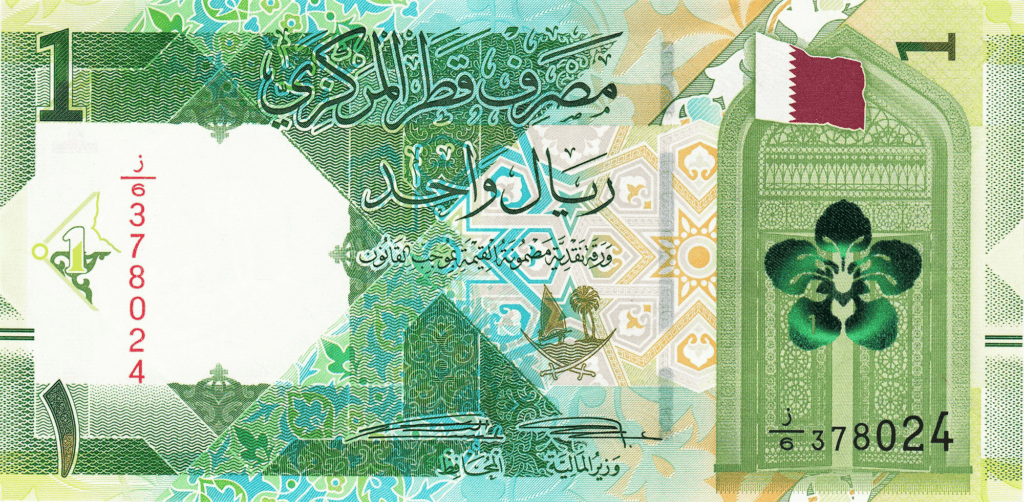
The QR 1 note, colored green, depicts the Flag of Qatar, the Dreama flower, and a gate symbolizing historical Qatari architecture on the obverse. The reverse shows a traditional Dhow (Bateel) and the Oyster and Pearl Monument.
QR 5
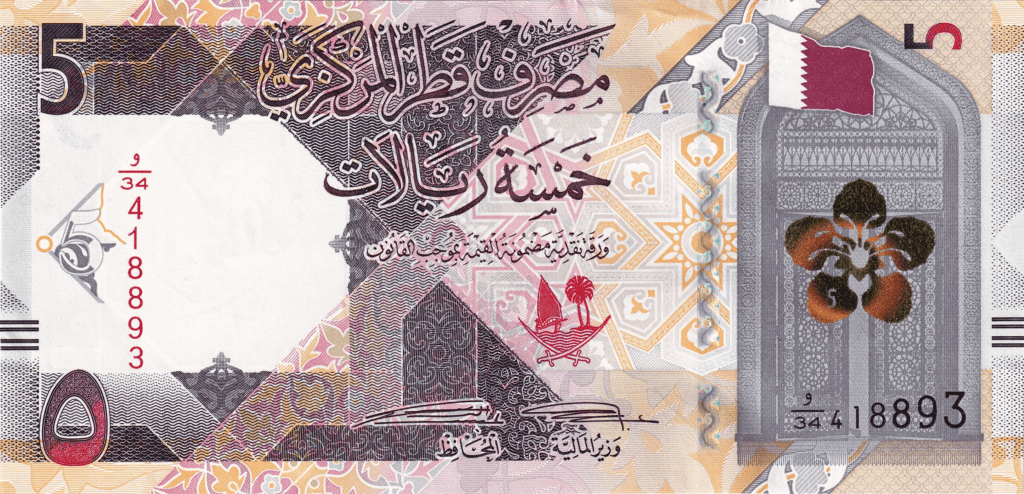
The QR 5 note in brown, depicts the Flag of Qatar, the Dreama flower, and a gate symbolizing historical Qatari architecture on the obverse. On the reverse, it showcases a traditional desert scene with Arab horses, camels, oryxes, flora (Al Qataf), and a hair tent (buryuut hajar).
QR 10
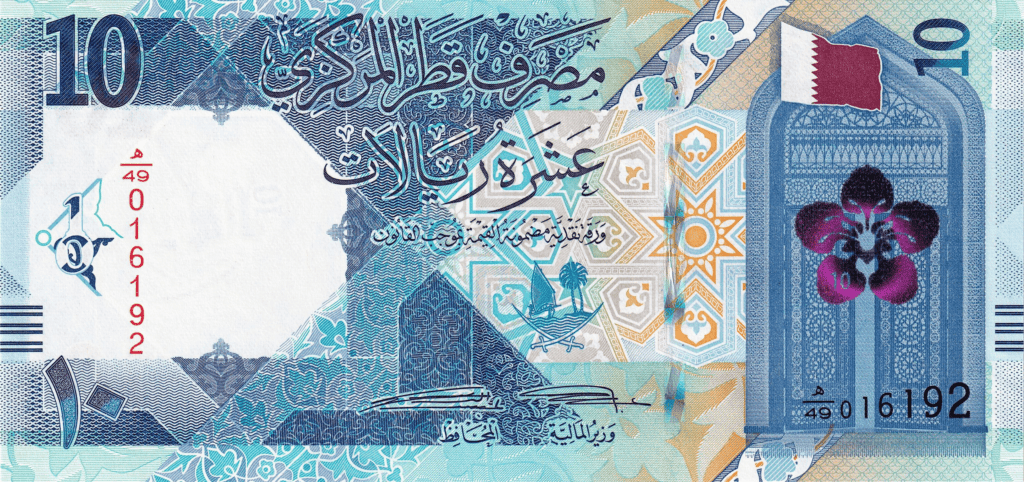
In blue, the QR 10 note depicts the Flag of Qatar, the Dreama flower, and a gate symbolizing historical Qatari architecture on the obverse. On the reverse, features Lusail Stadium, Torch Tower (Aspire Zone), and Sidra Medicine and Education City (Qatar Foundation).
QR 50
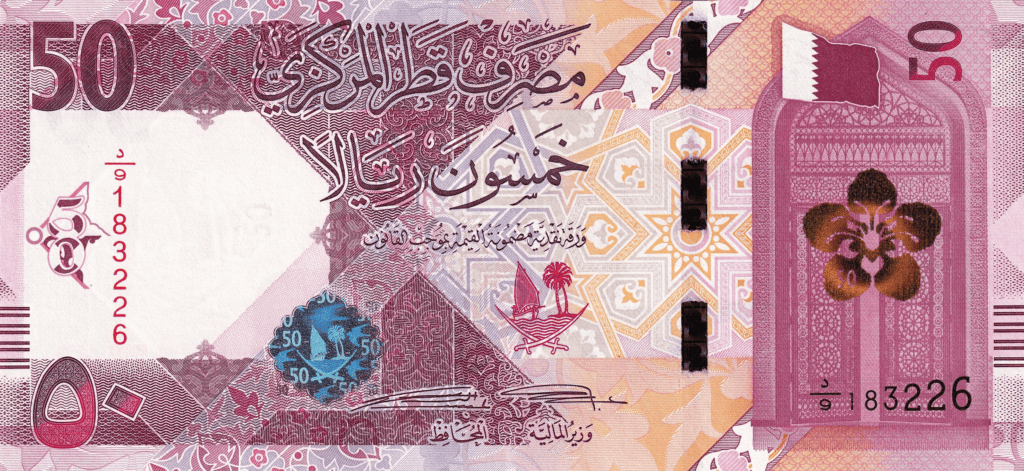
The QR 50 note, red in color, depicts the Flag of Qatar, the Dreama flower, and a gate symbolizing historical Qatari architecture on the obverse. The reverse displays the Qatar Central Bank building and the Ministry of Finance building.
QR 100
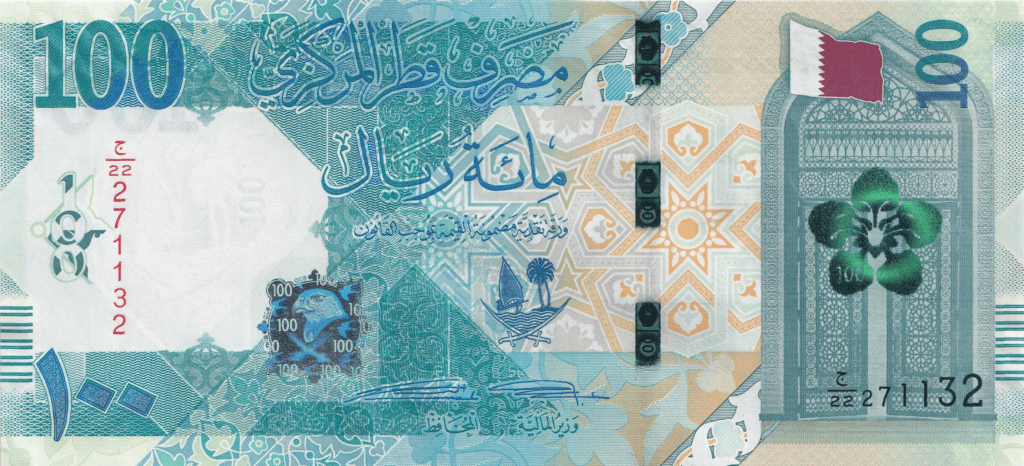
The QR 100 note, in cyan, depicts the Flag of Qatar, the Dreama flower, and a gate symbolizing historical Qatari architecture on the obverse. The reverse presents the Abu Al Qubaib Mosque.
QR 200
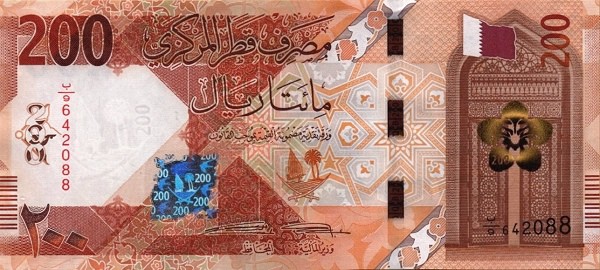
An orange QR 200 note depicts the Flag of Qatar, the Dreama flower, and a gate symbolizing historical Qatari architecture on the obverse. The reverse illustrates the Palace of Sheikh Abdullah bin Jassim Al Thani, Qatar National Museum, and Museum of Islamic Art.
QR 500

The QR 500 note, violet in hue, depicts the Flag of Qatar, the Dreama flower, and a gate symbolizing historical Qatari architecture on the obverse. The reverse depicts the Ras Laffan LNG refinery and an LNG canter ship.
Currency Usage in Qatar
In Qatar, located in the Arabian Peninsula, the official currency is the Qatari riyal (QAR), symbolized by the falcon’s wing and divided into 100 dirhams.
Since 2001, the riyal has been pegged to the US dollar at a fixed rate ensuring stability and predictability in its value. This pegging offers benefits like financial planning stability, ease of international trade, and inflation control.
Exchanging foreign currency into riyals is easy in Qatar, with ATMs available in major cities and competitive exchange rates offered at banks and money changers.
Some larger hotels and tourist shops may accept euros or pounds, but the riyal is preferred. While cash is commonly used, there’s a growing trend towards digital payments.
Credit cards are widely accepted, and mobile wallets and contactless payments are becoming more popular, especially in e-commerce.
Travelers are advised to carry some riyals upon arrival for immediate expenses. ATMs provide competitive exchange rates, and prepaid travel cards can be a convenient and secure option. Embracing cashless options like mobile wallets adds convenience.
It’s important to respect local customs, avoid showing off large amounts of cash, keep receipts for currency exchanges, and enjoy Qatar’s blend of tradition and modernity.
Is USD accepted in Qatar?
While the Qatari riyal is the official currency of Qatar, some businesses may accept US dollars (USD) as a form of payment. However, it is recommended to use Qatari riyal for all transactions as it is widely accepted throughout the country.
Additionally, using Qatari riyal will ensure that you are getting the correct exchange rate and avoiding any potential scams or extra fees.
When exchanging your currency for Qatari riyal, it is important to note that exchange rates may vary depending on the location and type of exchange service. It is recommended to exchange your currency at official exchange offices or banks to ensure that you are getting a fair rate.
Using Qatari riyal as the primary currency for transactions in Qatar is highly recommended. While some businesses may accept USD, it is best to avoid potential scams or extra fees by using the official currency.
When exchanging your currency, it is important to use official exchange offices or banks to ensure a fair rate.
Exchanging Currency in Qatar
Traveling to Qatar, a destination known for its desert landscapes and modern architecture, requires a bit of financial preparation, particularly exchanging your currency into Qatari riyals (QAR).
For a smooth financial experience in Qatar, it’s advisable to have some riyals ready upon arrival for immediate expenses like taxis and tips. Using ATMs is recommended for the best exchange rates.
Prepaid travel cards loaded with QAR can offer convenience and security, and embracing cashless payment options can add to your convenience. Always compare rates before exchanging money and keep your receipts for any currency exchange transactions.
Where can I exchange Qatar currency?
Exchanging currency in Qatar is straightforward. ATMs, available especially in cities like Doha, provide competitive exchange rates and are a convenient option.
Banks and exchange houses are also reliable sources for exchanging currency, though it’s wise to compare rates. Some hotels and shops catering to tourists may accept major foreign currencies, but using riyals is generally preferred.
You can exchange your currency at banks, exchange houses, and airports. Banks usually offer better exchange rates than exchange houses.
However, exchange houses are more convenient and have longer operating hours than banks. You can also exchange currency at the airport, but the exchange rates are usually less favorable than banks or exchange houses.
What to know before exchanging currency in Qatar
Before exchanging currency, it is important to know the current exchange rate. You can check the current exchange rate online or through currency converter apps. It is also important to check the exchange rate offered by different banks and exchange houses to get the best deal.
Digital payments are increasingly popular in Qatar. Credit cards are commonly accepted in hotels, restaurants, and major stores. Mobile wallets and contactless payments are also becoming more widely used, particularly among the younger population.
It is recommended to exchange only the amount of money you need for your trip as exchanging money back to your home currency may result in additional fees and unfavorable exchange rates.
It is also important to keep your exchange receipts as you may be required to show them when exchanging Qatari riyals back to your home currency.
Lastly, it is important to be aware of counterfeit currency. Qatar has recently introduced new currency notes, so make sure to exchange your currency at reputable banks or exchange houses to avoid counterfeit notes.
By following these tips, you can ensure that you get the best deal when exchanging currency in Qatar and avoid any issues with counterfeit currency.
Choosing Between USD and Qatar Currency
If you’re planning to visit Qatar, you’ll need to decide whether to use USD or the Qatari riyal (QAR) for your transactions. Here are some factors to consider when making your decision.
Exchange Rate
The Qatari riyal is a stable currency and is pegged to the US dollar at a fixed exchange rate. This means that the exchange rate between the two currencies remains relatively constant, making it easy to calculate the value of goods and services in Qatar.
The exchange rate between USD and QAR fluctuates daily. You should check the current exchange rate before making any transactions to ensure you’re getting the best deal.
Convenience
While USD is widely accepted in Qatar, it’s still recommended to carry QAR for smaller transactions. Larger establishments such as hotels and malls may accept USD, but smaller shops and restaurants may only accept QAR.
It’s also important to note that some establishments may only accept cash, so it’s a good idea to carry both currencies in case you need to make a cash transaction.
Fees
When exchanging currency, you may incur fees from banks or currency exchange offices. It’s important to compare fees and exchange rates to ensure you’re getting the best deal. Some establishments may also charge a fee for using a credit card, so it’s a good idea to carry cash as well.
Tips
When tipping in Qatar, it’s customary to tip in QAR. While USD may be accepted, it’s best to use the local currency to avoid confusion or misunderstandings. It’s also important to note that tipping is not mandatory in Qatar, but it’s appreciated for good service.
In summary, while USD is widely accepted in Qatar, it’s still recommended to carry QAR for smaller transactions and tipping. Be sure to compare exchange rates and fees to ensure you’re getting the best deal.
Cost of Living in Qatar
Qatar is known for its high cost of living, but it is also a country that offers a high standard of living. Although the cost of living in Qatar is high, it is still relatively cheaper than other Gulf Cooperation Council (GCC) countries like the UAE and Saudi Arabia.
Housing is the most significant expense in Qatar, with rent taking up a significant portion of the average person’s income.
The cost of renting a one-bedroom apartment in the city center can range from QAR 3,500 to QAR 6,000 (~$960-1648 USD) per month, while a three-bedroom apartment can cost between QAR 8,000 to QAR 14,000 (~$2197-3845 USD) per month. If you’re on a tight budget, you may be able to find a room to rent for around QAR 2,500 (~$686 USD) per month.
Food prices in Qatar can be relatively high, especially for imported products. However, there are plenty of local markets and grocery stores where you can find fresh produce at reasonable prices. Eating out can be expensive, with a meal at a mid-range restaurant costing around QAR 80 to QAR 120 (~$20-34 USD) per person.
Transportation costs in Qatar are relatively low compared to other GCC countries. The country has an extensive public transportation system, including buses, taxis, and metro lines. The average taxi fare in Qatar is around QAR 20, while a one-way ticket on the metro costs QAR 2.
Healthcare in Qatar is of a high standard, with both public and private hospitals available. However, private healthcare can be expensive, and it is essential to have health insurance. A visit to a general practitioner can cost around QAR 150 to QAR 250, while a specialist consultation can cost up to QAR 500.
Overall, the cost of living in Qatar can be high, but it is possible to live comfortably if you budget accordingly. It is essential to do your research and plan your expenses carefully to ensure that you can afford to live in Qatar comfortably.
Don’t Get Scammed Tips
When it comes to currency exchange in Qatar, it’s important to be aware of potential scams. Here are some tips to help you avoid being scammed:
1. Use reputable currency exchange services
Make sure you use reputable currency exchange services when exchanging currency. Avoid exchanging currency with individuals or businesses that you don’t know or trust. Look for currency exchange services that are licensed by the Qatar Central Bank.
2. Be aware of counterfeit currency
Counterfeit currency is a problem in Qatar, so it’s important to be aware of the security features of the Qatari riyal. Look for security features such as watermarks, security threads, and holograms. If you receive a suspicious note, don’t accept it and report it to the authorities.
3. Check exchange rates
Before exchanging currency, check the exchange rates to make sure you’re getting a fair deal. You can check the exchange rates online or at a currency exchange service. Be wary of exchange rates that are significantly different from the official rate.
4. Avoid street money changers
Avoid exchanging money with street money changers. They often offer better exchange rates than official currency exchange services, but they may be involved in illegal activities or give you counterfeit currency.
5. Keep your money safe
Keep your money safe by using a money belt or a secure wallet. Don’t carry large amounts of cash with you, and be aware of your surroundings when using ATMs or exchanging currency.
By following these tips, you can avoid being scammed when exchanging currency in Qatar.

